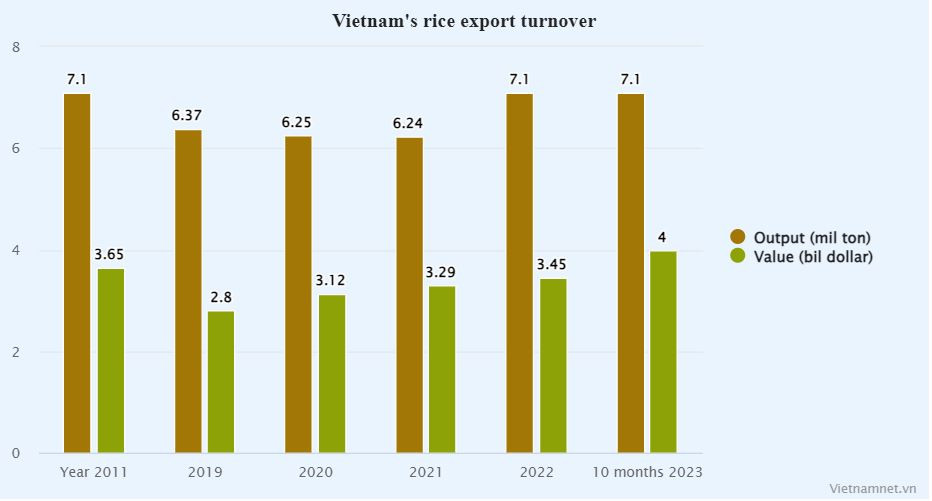
The Ministry of Agriculture and Rural Development (MARD) reported that Vietnam exported 7.12 million tons of rice in the first 10 months of the year with turnover of $4 billion. The figure represented the 34.9 percent increase in comparison with the same period last year and the export turnover officially set a record for the last 34 years since Vietnam began exporting rice.
According to Vietnam Food Association (VFA), the prices are on the rise. On November 1, Vietnam’s five percent broken rice was traded at $653 per ton, and 25 percent broken rice $638 per ton. As the rice price reached the historic peak, Vietnam’s rice price has become the most expensive in the world.
At present, Vietnam’s 5 percent broken rice is $93 per ton higher than Thailand’s same kind of rice, and $90 higher than Pakistan’s. The figures are $118 and $150 per ton, respectively, for 25 percent broken rice.
As such, Vietnam’s 5 percent broken rice export price has increased by 38 percent compared with the beginning of the year, and 25 percent broken rice 40.8 percent. To date, both selling prices and export turnover have set records.
In late July, when India prohibited rice exports, experts predicted that the short supply and sharp price increases would be opportunities for Vietnam to boost exports and help farmers and exporters earn bigger money. However, in fact, profits for big rice exporters have decreased.
Loc Troi’s third quarter financial report showed that its net revenue in the third quarter was VND4.461 trillion, up 63 percent compared with the same period last year. Of this, revenue from rice was VND4 trillion, or 2.5 times higher than the same period last year.
However, to many analysts’ surprises, when the export price was soaring, Loc Troi reported a loss of VND327 billion (it made a profit of VND64 billion the same period last year).
Loc Troi Group’s CEO Nguyen Duy Thuan explained that its post-tax profit dropped sharply in the third quarter because of cost increases, especially expenses on loan interests, and the loss caused by the exchange rate fluctuations.
As of the end of September, Loc Troi had net revenue of VND10.44 trillion, up 18 percent, but its profit was just VND20 billion, down 91 percent.
Meanwhile, Trung An Hi-tech Agriculture reported a modest profit of VND11.9 billion in the third quarter, a slight increase compared with the VND11.06 billion of the same period last year.
Its 9-month net revenue reached VND3.479 trillion, up 57 percent, but revenue decreased by 75 percent to VND12.8 billion.
Vietnam told to be cautious about supply
In the talk with VietNamNet, Pham Thai Binh, vice president of Trung An, several times recalled the story about export companies facing difficulties during the ‘global price fever’.
He said export volume and export turnover increased in recent months, but production costs rose significantly, while export companies have not been as they must pay high interest rates and domestic rice prices increased more sharply than export prices.
The paddy price has soared by 36.6 percent in fields, and by 37.9 percent at warehouses. The prices of first-class white rice increased by 41.5 percent, 5 percent of broken rice 49.7 percent, while 25 percent broken rice prices by 50.8 percent.
Also, according to Binh, export companies now have to pay VND8,000-8,200 per kilogram to collect paddy in fields, the highest level so far. With the input cost, export companies need to export rice at $670-680 per ton to gain reasonable profits, but in fact, they can sell at $653 per ton only. This means that export companies do not make profit, or even take a loss if they sign contracts now.
Do Ha Nam, deputy chair of the Vietnam Food Association (VFA), admitted that many enterprises have canceled contracts because of huge losses.
“Vietnam’s enterprises sign contracts with late deliveries and they now have to pay a lot to collect rice to deliver products as scheduled,” he explained, saying that while revenue increases, profit goes down.
Some experts warned that the high export prices don’t mean an advantage, but may pose high risks. Enterprises dare not store products now. They have also warned of losing competitiveness compared with rivals.
Tam An